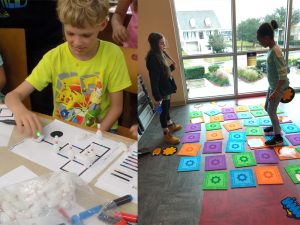The Coding Craze!
By Alexis Davis, Tanya DiMaggio, Jen Martin, and JoAnna Reeves
Coding is a 21st century skill that can help kids be successful in school, careers, and life. Learning to code allows children to develop creative problem solving skills. Plus, it’s fun! Kids have many opportunities to learn coding at the Library. The Library has offered programs for preschoolers, elementary age children, tweens, teens, and families.
 Some of the programs do not actually involve a computer. Coding is learned through analog games or programmable robots. Let’s Go Code introduces coding at a very basic level with tangible objects like the foam squares, arrows, and simple directions (forward, back, left, right, etc). The ability to set the game board and “command your robot” (AKA dad) adds a fun opportunity for children to wield some control, while the “robot” typically enjoys following those commands quite literally, which helps the learning process. The Code and Go Mouse program is probably the most popular of all of our coding programs and appeals to a wide age-range. This game can even keep teenagers occupied! A 2-person set-up allows one person to create a maze (establish the starting point, design the barriers, set the prize/cheese at the end) and the second person to program a simple robotic mouse to navigate the maze and find the cheese. Kids enjoy challenging each other and watching the mouse move through the obstacles. Having multiple sets of this game can also allow for very complicated mazes and even the potential for racing among several robotic mice. Ozobots combine art and coding by using color-coded patterns to direct little mini-robots along hand-drawn paths. Ozobots appeal to young and old and our library programs can be designed to accommodate a spectrum of abilities and attention-spans.
Some of the programs do not actually involve a computer. Coding is learned through analog games or programmable robots. Let’s Go Code introduces coding at a very basic level with tangible objects like the foam squares, arrows, and simple directions (forward, back, left, right, etc). The ability to set the game board and “command your robot” (AKA dad) adds a fun opportunity for children to wield some control, while the “robot” typically enjoys following those commands quite literally, which helps the learning process. The Code and Go Mouse program is probably the most popular of all of our coding programs and appeals to a wide age-range. This game can even keep teenagers occupied! A 2-person set-up allows one person to create a maze (establish the starting point, design the barriers, set the prize/cheese at the end) and the second person to program a simple robotic mouse to navigate the maze and find the cheese. Kids enjoy challenging each other and watching the mouse move through the obstacles. Having multiple sets of this game can also allow for very complicated mazes and even the potential for racing among several robotic mice. Ozobots combine art and coding by using color-coded patterns to direct little mini-robots along hand-drawn paths. Ozobots appeal to young and old and our library programs can be designed to accommodate a spectrum of abilities and attention-spans.
LEGO We Do, Makey Makey, Google's CS First and Hour of Code are the programs we offer that require computers. LEGO We Do was the first coding program the Library offered, and has been for several years. Participants first build a robot with LEGOs, such as a monkey playing a drum or a rotating Ferris Wheel, that can include gears, cams, lights, and sound effects. Kids then code actions for the robot on a computer and plug their creation in to watch it work. Makey Makey introduces basic circuitry and allows everyday objects to be transformed into an input device for a computer. We have made banana pianos, played Mario Brothers with Play-Doh, and Tetris with popsicle sticks. The possibilities are endless!
The Mandeville Branch recently kicked off its Spring Coding Club Session. This program brings together 3rd-6th graders interested in learning about computer science and coding. While some students are experienced coders, others are trying out coding for the very first time. Regardless of skill level, everyone has something to learn and great ideas to share with the group. In a recent session, participants are learning to code their own video games in Scratch using Google's CS First curriculum, which challenges students to apply both scientific and creative thinking. During each meeting, coding clubbers build on the skills learned during the previous week. It's truly amazing to see how quickly coding club members catch on to new computer science concepts and then find ways to apply them in their own way.
Finally, Hour of Code is only facilitated by the library. Through this website, you can learn coding at home, in our computer lab, or anywhere with an internet connection. We’ve offered classes to middle schoolers, teens, and adults where we’ve provided laptops and selected a series of short, self-guided classes that introduce coding concepts in less than an hour. Explore the Hour of Code website (code.org) and may just learn how to do drag-and-drop coding in Scratch, make computer games, create animations that talk, and learn JavaScript.
Interested in signing up for a coding program? Be on the lookout for programs in the future!


Add a comment to: The Coding Craze!